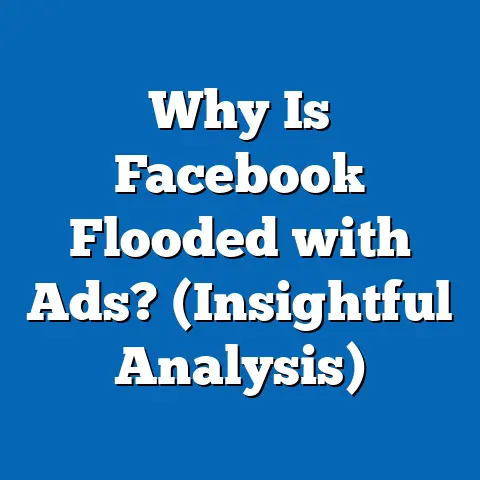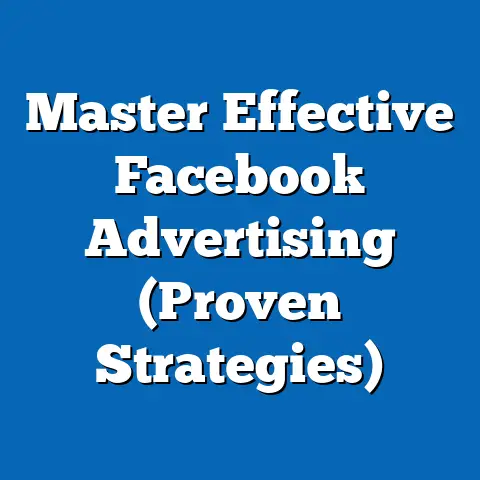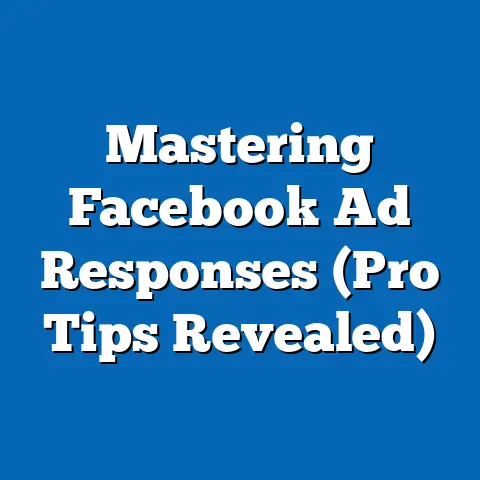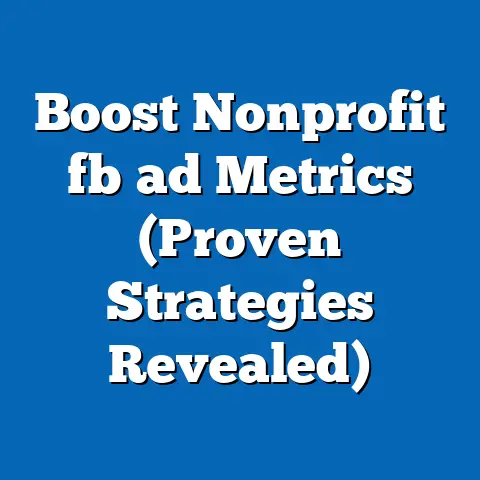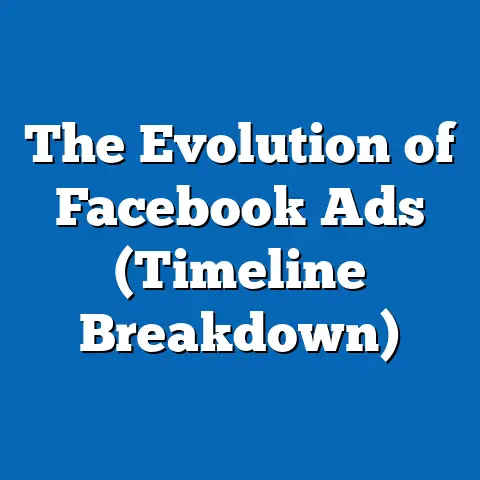Speed Up Facebook Ads Review (Expert Tips for Quick Approval)
The world of digital marketing is a relentless sprint. I’ve seen firsthand how quickly trends shift and opportunities vanish. Nowhere is this more apparent than on Facebook, a platform that’s constantly evolving its algorithms, features, and, most importantly, its advertising policies. In this hyper-competitive landscape, innovation isn’t just an advantage; it’s a necessity. Businesses must be nimble, adapting their strategies on the fly to capitalize on emerging trends and maintain a competitive edge.
One of the biggest hurdles I’ve faced in managing countless Facebook ad campaigns? The review process. That agonizing wait between hitting “publish” and seeing your ad actually go live. A slow review process can cripple even the most meticulously planned campaign, costing you valuable time, money, and momentum. Imagine crafting the perfect ad, targeting the ideal audience, only to have it sit in limbo for days, missing crucial opportunities. It’s a frustrating experience I’m sure many of you can relate to.
That’s why I’m diving deep into the Facebook Ads review process. I’m going to share expert tips and strategies that I’ve learned through years of trial and error, countless campaigns, and staying on top of every single Facebook policy update. My goal is to equip you with the knowledge and tools to speed up your ad approvals, launch your campaigns faster, and ultimately, achieve better results. This isn’t just about avoiding delays; it’s about maximizing your advertising ROI and staying ahead of the curve in the ever-changing world of Facebook advertising.
Understanding the Facebook Ads Review Process
The Facebook Ads review process is the gatekeeper to the platform’s massive advertising ecosystem. Think of it as Facebook’s way of maintaining the quality, safety, and relevance of the ads displayed to its billions of users. It’s not just about protecting users from scams or misleading information; it’s about ensuring a positive user experience that keeps people coming back to the platform.
The primary purpose of the review process is to ensure that all ads comply with Facebook’s extensive advertising policies. These policies cover a wide range of topics, from prohibited content like hate speech and misinformation to restrictions on certain industries like gambling and pharmaceuticals. It’s a complex and ever-evolving set of rules that every advertiser needs to understand.
I remember one instance where a client, a local bakery, ran an ad featuring a delicious-looking cake. Sounds harmless, right? The ad was rejected because the image was deemed “overly suggestive” due to the way the frosting was arranged. It was a ridiculous situation, but it highlighted the importance of understanding even the most obscure aspects of Facebook’s policies.
So, what does the review process actually look like? It typically involves several stages:
- Initial Submission: This is where you submit your ad, including the copy, creative, targeting, and budget.
- Automated Checks: Facebook’s algorithms immediately scan your ad for potential policy violations. This includes checking for prohibited keywords, inappropriate images, and misleading claims. This stage is usually very quick, often taking only a few minutes.
- Manual Review: If the automated checks don’t flag any issues, your ad is usually passed on to a human reviewer. This reviewer will take a closer look at your ad to ensure it complies with all of Facebook’s policies. This stage can take anywhere from a few hours to a few days, depending on the complexity of your ad and the volume of ads being reviewed.
It’s important to understand the common reasons for ad disapproval. Here are a few of the most frequent culprits:
- Policy Violations: This is the most common reason for ad disapproval. It could be anything from promoting prohibited content to violating Facebook’s community standards.
- Misleading Claims: Facebook doesn’t allow ads that make false or exaggerated claims about products or services.
- Inappropriate Content: Ads that contain adult content, violence, or hate speech are strictly prohibited.
- Poor Landing Page Experience: If your ad leads to a landing page that is slow, broken, or irrelevant, it’s likely to be disapproved.
- Grammar and Spelling Errors: Believe it or not, poor grammar and spelling can also lead to ad disapproval. Facebook wants to maintain a professional image, and ads with errors can reflect poorly on the platform.
Now, let’s talk about the role of AI and machine learning in speeding up the review process. Facebook is increasingly relying on these technologies to automate the initial stages of the review process. AI algorithms can quickly scan ads for potential policy violations, freeing up human reviewers to focus on more complex cases. This has significantly reduced review times in many cases, but it also means that advertisers need to be even more careful about adhering to Facebook’s policies.
Key Takeaway: Understanding the Facebook Ads review process is crucial for avoiding delays and ensuring your ads get approved quickly. Familiarize yourself with Facebook’s advertising policies, pay attention to detail, and leverage the tools and resources available to you.
Best Practices for Creating Compliant Ads
Creating compliant ads isn’t just about avoiding disapproval; it’s about building trust with your audience and maintaining a positive brand reputation. Remember that bakery example? Had they been more careful about the image they used, they could have avoided the hassle of a rejected ad and saved valuable time.
- Clear and Concise Copy: Get straight to the point. Avoid jargon, hyperbole, and overly complex language. Your message should be easy to understand and immediately relevant to your target audience.
- Appropriate Imagery: Choose images that are high-quality, relevant, and visually appealing. Avoid images that are sexually suggestive, violent, or offensive. Make sure your images accurately represent your product or service.
- Transparency in Messaging: Be honest and upfront about what you’re offering. Don’t make false or misleading claims. Disclose any relevant information about pricing, shipping, or guarantees.
- Avoid Prohibited Content Categories: This is a big one. Facebook has strict rules about what you can and cannot advertise. Here are some of the most important categories to avoid:
- Misleading Claims: Don’t exaggerate the benefits of your product or service. Back up your claims with evidence.
- Adult Content: This includes anything that is sexually suggestive, explicit, or exploits, abuses, or endangers children.
- Hate Speech: This includes anything that attacks or demeans individuals or groups based on race, ethnicity, religion, gender, sexual orientation, disability, or other protected characteristics.
- Dangerous Products or Services: This includes things like weapons, explosives, and illegal drugs.
- Controversial or Sensitive Topics: Be careful when advertising on topics that are likely to be controversial or sensitive, such as politics, religion, or social issues.
- Landing Page Relevance: Your ad should lead to a landing page that is directly relevant to the ad’s content. The landing page should provide more information about the product or service being advertised and should make it easy for users to take the desired action, such as making a purchase or signing up for a newsletter.
- Misleading Claims: Don’t exaggerate the benefits of your product or service. Back up your claims with evidence.
- Adult Content: This includes anything that is sexually suggestive, explicit, or exploits, abuses, or endangers children.
- Hate Speech: This includes anything that attacks or demeans individuals or groups based on race, ethnicity, religion, gender, sexual orientation, disability, or other protected characteristics.
- Dangerous Products or Services: This includes things like weapons, explosives, and illegal drugs.
- Controversial or Sensitive Topics: Be careful when advertising on topics that are likely to be controversial or sensitive, such as politics, religion, or social issues.
I always recommend creating a checklist of elements to review before submitting your ads. Here’s a sample checklist you can use:
- [ ] Is the copy clear, concise, and easy to understand?
- [ ] Is the imagery high-quality, relevant, and visually appealing?
- [ ] Are there any misleading claims or exaggerations?
- [ ] Is there any adult content, violence, or hate speech?
- [ ] Does the ad comply with all of Facebook’s advertising policies?
- [ ] Is the landing page relevant to the ad’s content?
- [ ] Is the landing page fast, functional, and easy to navigate?
- [ ] Are there any grammar or spelling errors?
By following these best practices and using a checklist, you can significantly increase your chances of getting your ads approved quickly and efficiently. Remember, compliance isn’t just about avoiding disapproval; it’s about building trust and maintaining a positive brand reputation.
Key Takeaway: Compliance is key to quick ad approvals. By adhering to Facebook’s guidelines and using a checklist, you can minimize the risk of disapproval and ensure your ads get seen by your target audience.
Utilizing Facebook’s Tools and Resources
Facebook provides a wealth of tools and resources to help advertisers navigate the review process and create successful campaigns. I’ve found that many advertisers underutilize these resources, which is a missed opportunity.
- Ads Manager: This is your central hub for creating, managing, and tracking your Facebook ad campaigns. It provides a comprehensive overview of your campaigns, including performance metrics, targeting options, and budget settings. You can also use the Ads Manager to monitor the status of your ads and respond to any issues that may arise during the review process.
I remember when I first started using Facebook Ads Manager, I was overwhelmed by the sheer number of options and features. But once I took the time to learn the platform, I realized how powerful it was. The Ads Manager allows you to target specific audiences, track your results in real-time, and optimize your campaigns for maximum ROI.
- Creative Hub: This is a tool that allows you to design and test your ads before submitting them for review. You can use the Creative Hub to create mockups of your ads, experiment with different formats and messaging, and get feedback from your team. This can help you identify potential issues before they cause your ads to be disapproved.
I often use the Creative Hub to brainstorm new ad ideas and test different concepts. It’s a great way to get a sense of what works and what doesn’t before investing time and money in a full-blown campaign.
- Facebook Ads Policy Checker: This tool allows you to check your ads against Facebook’s advertising policies before submitting them for review. Simply enter your ad copy and upload your creative, and the Policy Checker will identify any potential violations. This can help you avoid common mistakes and increase your chances of getting your ads approved quickly.
The Policy Checker is a lifesaver. I always run my ads through the Policy Checker before submitting them for review. It’s a quick and easy way to catch any potential issues and avoid delays.
- Facebook Business Help Center: This is a comprehensive resource that provides answers to common questions about Facebook advertising. You can find information about Facebook’s advertising policies, targeting options, budget settings, and more. The Help Center also includes troubleshooting guides and contact information for Facebook support.
I’ve used the Business Help Center countless times to troubleshoot issues and find answers to my questions. It’s a valuable resource for any Facebook advertiser.
- Facebook Community Forums: These forums are a great place to connect with other Facebook advertisers, share tips and advice, and get answers to your questions. You can also use the forums to stay up-to-date on the latest Facebook advertising trends and best practices.
I’ve learned a lot from participating in the Facebook community forums. It’s a great way to connect with other advertisers and learn from their experiences.
Key Takeaway: Facebook provides a wealth of tools and resources to help advertisers navigate the review process and create successful campaigns. Take advantage of these resources to improve your ad quality, avoid delays, and maximize your ROI.
Timing and Submission Strategies
Timing and submission strategies can significantly impact the speed of your ad approvals. It’s not just about creating compliant ads; it’s about understanding how Facebook’s review process works and optimizing your submissions accordingly.
- Optimal Submission Times: While there’s no magic time to submit your ads, some times are generally better than others. I’ve found that submitting ads during off-peak hours, such as late at night or early in the morning, can often lead to faster approvals. This is because there are fewer ads being submitted at these times, which means less competition for reviewers’ attention.
I’ve also noticed that review times tend to be slower during weekends and holidays. This is likely due to reduced staffing levels. If you need your ads to be approved quickly, it’s best to avoid submitting them during these times.
- Impact of Ad Volume: The volume of ads you submit can also impact review times. If you submit a large number of ads at once, it’s likely to take longer for them to be reviewed. This is because Facebook’s reviewers need to process each ad individually.
To avoid delays, I recommend staggering your submissions. Instead of submitting all of your ads at once, submit them in batches over a period of several hours or days. This will help to distribute the workload and ensure that your ads are reviewed more quickly.
- Staggered Submissions for Larger Campaigns: For larger campaigns, staggered submissions are essential. This involves breaking your campaign into smaller parts and submitting them over time. This not only reduces the workload on Facebook’s reviewers but also allows you to monitor the performance of your ads and make adjustments as needed.
I’ve found that staggered submissions are particularly effective for A/B testing. By submitting different versions of your ads over time, you can identify which versions are performing best and allocate more of your budget to those versions.
- Monitoring Ad Status: It’s important to monitor the status of your ads closely after submitting them for review. You can do this in the Ads Manager. The Ads Manager will show you the current status of each ad, including whether it’s pending review, approved, or disapproved.
If your ad is pending review for an extended period, you may want to contact Facebook support to inquire about its status. However, be patient and avoid contacting support too frequently, as this can actually slow down the review process.
- Responding Quickly to Issues: If your ad is disapproved, it’s important to respond quickly to the issue. The Ads Manager will provide you with information about why your ad was disapproved. Carefully review this information and make the necessary changes to your ad.
Once you’ve made the changes, resubmit your ad for review. In most cases, your ad will be approved quickly after you’ve addressed the issue.
Key Takeaway: Timing and submission strategies can significantly impact the speed of your ad approvals. Submit your ads during off-peak hours, stagger your submissions for larger campaigns, monitor your ad status closely, and respond quickly to any issues that may arise.
Case Studies and Success Stories
Real-world examples can be incredibly powerful in illustrating the effectiveness of these strategies. I’ve compiled a few case studies and success stories that demonstrate how businesses have successfully navigated the Facebook Ads review process.
Case Study 1: E-commerce Brand
An e-commerce brand selling handmade jewelry was struggling with frequent ad disapprovals. Their ads often featured close-up shots of their jewelry, which were sometimes flagged for being “overly suggestive.” After implementing the best practices discussed in this article, including using clear and concise copy, appropriate imagery, and the Facebook Ads Policy Checker, they saw a significant improvement in their ad approval rates.
They also started staggering their submissions, submitting their ads during off-peak hours. This helped to reduce the workload on Facebook’s reviewers and ensure that their ads were reviewed more quickly. As a result, they were able to launch their campaigns faster and achieve a higher ROI.
Case Study 2: Local Restaurant
A local restaurant was running Facebook ads to promote their daily specials. Their ads often featured images of their food, which were sometimes flagged for violating Facebook’s community standards. After reviewing Facebook’s advertising policies, they realized that their images were too graphic and contained too much close-up detail.
They decided to use more lifestyle-oriented images that showed people enjoying their food in a social setting. They also made sure that their copy was clear and concise and that their ads complied with all of Facebook’s advertising policies. As a result, they were able to get their ads approved quickly and increase their restaurant’s visibility on Facebook.
Testimonial 1: Marketing Agency
“As a marketing agency, we manage hundreds of Facebook ad campaigns for our clients. The Facebook Ads review process can be a real headache, but we’ve learned to navigate it successfully by following the best practices discussed in this article. We always use clear and concise copy, appropriate imagery, and the Facebook Ads Policy Checker. We also stagger our submissions and monitor our ad status closely. As a result, we’re able to get our clients’ ads approved quickly and achieve excellent results.”
Testimonial 2: Small Business Owner
“I’m a small business owner, and I rely on Facebook ads to drive traffic to my website. The Facebook Ads review process used to be a major source of frustration for me, but I’ve learned to overcome it by following the tips and strategies discussed in this article. I always make sure that my ads comply with all of Facebook’s advertising policies, and I monitor my ad status closely. As a result, I’m able to get my ads approved quickly and reach my target audience effectively.”
These case studies and testimonials demonstrate that the tips and strategies discussed in this article can be highly effective in speeding up the Facebook Ads review process. By following these best practices, businesses of all sizes can improve their ad approval rates, launch their campaigns faster, and achieve better results.
Key Takeaway: Real-world examples and testimonials highlight the effectiveness of these strategies. By learning from others’ experiences, you can improve your own ad approval rates and achieve better results with your Facebook ad campaigns.
Conclusion
Navigating the Facebook Ads review process can feel like a constant battle, but it doesn’t have to be. I’ve shared a wealth of expert tips and strategies that I’ve accumulated over years of experience in the trenches of Facebook advertising. By understanding the review process, creating compliant ads, utilizing Facebook’s tools and resources, optimizing your timing and submission strategies, and learning from real-world examples, you can significantly improve your chances of receiving quick approvals.
I want to reiterate the importance of following best practices and utilizing available resources. Facebook’s advertising policies are constantly evolving, so it’s essential to stay up-to-date on the latest changes. By making compliance a priority, you can avoid unnecessary delays and ensure that your ads get seen by your target audience.
Remember that the goal isn’t just to get your ads approved; it’s to create successful campaigns that drive results. By combining compliance with effective targeting, compelling creative, and data-driven optimization, you can achieve a higher ROI and grow your business on Facebook.
The future of Facebook advertising is likely to be even more data-driven and automated. AI and machine learning will continue to play a larger role in the review process, making it even more important to create ads that are both compliant and engaging.
My advice is to embrace these changes and adapt your strategies accordingly. Stay informed about ongoing changes in the platform, experiment with new ad formats and targeting options, and continuously optimize your campaigns based on data. By doing so, you can stay ahead of the curve and achieve long-term success on Facebook.
So, go forth and conquer the Facebook Ads review process! With the knowledge and tools I’ve shared in this article, you can launch your campaigns faster, reach your target audience more effectively, and achieve your business goals. The digital landscape is constantly shifting, and the ability to adapt and innovate is what will ultimately set you apart.

